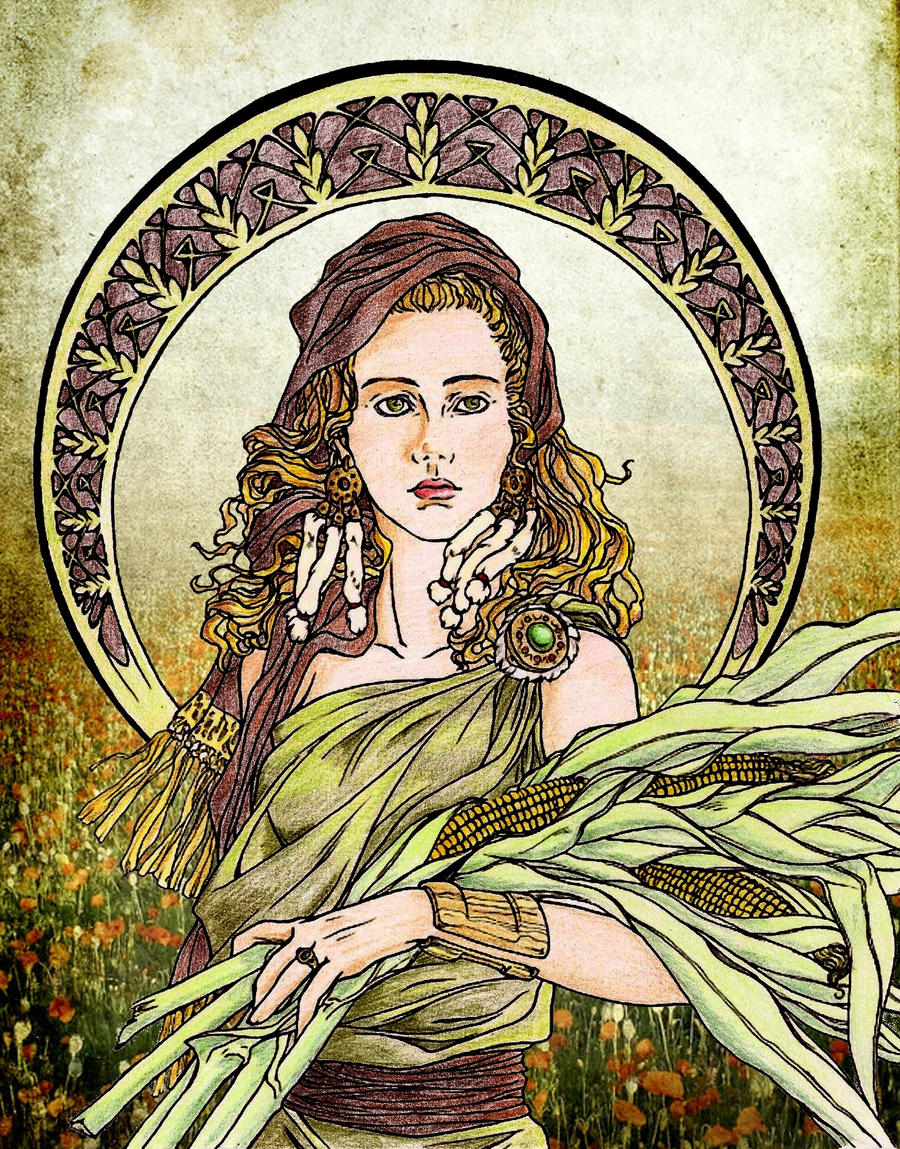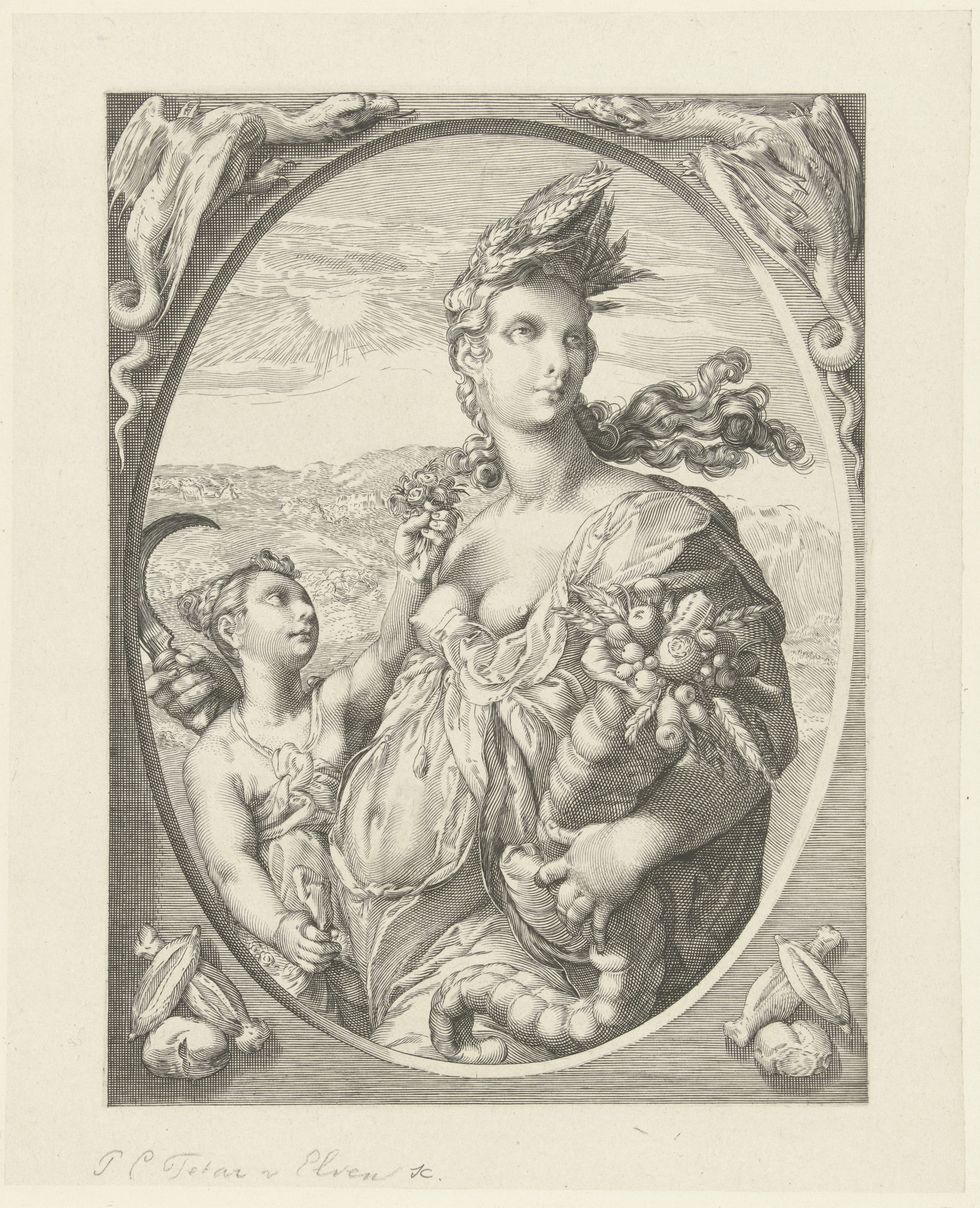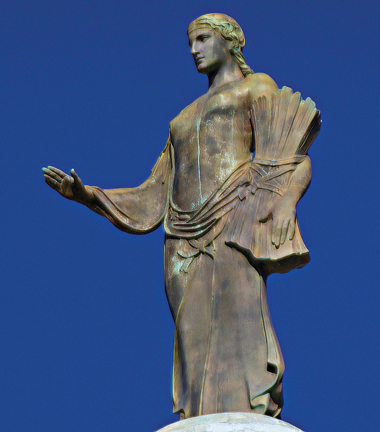Ceres: The Roman Goddess of Agriculture and Fertility
Ceres, known as the Roman goddess of agriculture, fertility, and the harvest, holds a significant place in Roman mythology. Revered as a maternal figure and a guardian of the earth’s bounty, she symbolizes the cycles of growth, cultivation, and abundance. Ceres is often depicted as a regal and serene woman, adorned with a crown or wreath made of wheat, reflecting her close association with the cultivation of crops.
Her presence represents the vital role of agriculture in sustaining civilizations and nourishing communities. As a nurturer and provider, Ceres ensures the fertility of the land, the success of crops, and the prosperity of those who depend on the fruits of the earth. Her influence extends beyond the agricultural realm, as she also represents the cycle of life, death, and rebirth. Ceres serves as a reminder of the profound connection between humanity and the natural world, emphasizing the importance of honoring and preserving the delicate balance between human activities and the environment.
Overview of Ceres
Ceres is associated with agriculture, crops, and fertility. She holds the power to nurture and foster the growth of crops, ensuring bountiful harvests and the sustenance of communities. Ceres is revered as a maternal figure, caring for the well-being of humanity, and offering protection to women and children. Her story is intertwined with the changing seasons, as her grief over the abduction of her daughter, Proserpina, leads to periods of barrenness and famine on Earth.
Ceres embodies the cyclical nature of life, death, and rebirth, symbolizing the transformative forces of nature and the regenerative power of the earth. She is honored in festivals and rituals celebrating the harvest and the abundance of agricultural produce. As a goddess deeply connected to the land, Ceres holds a significant place in Roman mythology and cultural beliefs surrounding agriculture and fertility. Ceres is primarily known by her Roman name, however, she is sometimes referred to as Demeter due to her close association to the Greek goddess of agriculture.

Source: Deviantart – “Art Nouveau – Demeter” by sterendenn
Titles
- Goddess of Agriculture
- Goddess of Fertility
- Patroness of Harvest
- Protector of Farmers
- Goddess of Motherhood
- Goddess of Seasons
- Goddess of Nurturing
- Granary Goddess
Abilities
Ceres’ abilities showcase her divine mastery over the agricultural realm, her nurturing qualities, and her pivotal role in sustaining life and fertility in the natural world. Ceres has the extraordinary ability to nurture and foster the growth of crops and influence the changing seasons. She embodies the concept of renewal, reminding humanity of the enduring cycles and the potential for growth even in the face of adversity. With a natural affinity for healing and nurturing, Ceres safeguards the welfare of families, women, and children, monitoring their health, and providing support during childbirth and early stages of life.
Characteristics
Ceres is typically depicted as a mature woman of regal stature and serene countenance. She is often portrayed wearing a flowing, simple gown or robes, symbolizing her association with agriculture and the harvest. Her garments may be adorned with intricate patterns or sheaves of wheat, representing the abundance of the harvest and fertility of the land.
Symbols

Source: Rijks Museum
A 19th-century depiction of Ceres and Proserpina shows Proserpina gazing at her mother. Ceres holds an overflowing cornucopia in one hand and a sickle in the other, symbolizing abundance and protection.
A cornucopia, a sheaf of wheat, and a poppy flower are commonly associated with Ceres. The cornucopia, also known as the “horn of plenty,” is one of the most recognizable symbols. It is depicted as a horn-shaped basket overflowing with fruits, vegetables, and grains, representing a bountiful harvest. Its association with Ceres signifies her role in bestowing fertility and prosperity upon the land. Wheat was a vital cereal crop in ancient Rome, and Ceres is often portrayed cradling a bundle of wheat stalks, emphasizing her role in its cultivation. Less commonly, the poppy flower represents fertility and regeneration, reflecting Ceres’ relationship to life, death, and rebirth.
Festivals and Rituals
The worship of Ceres in ancient Rome was accompanied by various festivals and rituals dedicated to the goddess. One of the most significant festivals was the Cerealia, held in April, which spanned multiple days and involved elaborate ceremonies. During this festival, the city of Rome would come alive with vibrant processions, musical performances, and theatrical shows. People adorned themselves with garlands of flowers and carried torches to honor Ceres. Offerings of wheat, honey, and other agricultural products were made at her temples and altars. The streets were filled as people expressed their gratitude for the bountiful harvests and sought Ceres’ blessings for future abundance.
Legends Associated With Ceres
The Roman goddess of agriculture is shrouded in captivating legends. These tales reveal her divine power over crops, fertility, and the cyclical nature of life.
Origin Story
Ceres does not have a traditional birth story. Instead, she is often considered to be one of the more ancient and primordial deities. Ceres is believed to have been present since the earliest times. She was regarded as an essential force in the natural order and the fertility of the land. The Romans considered her a goddess who had always existed, intimately connected to the cycles of agriculture and the growth of crops.
It’s important to note that Roman mythology often drew from Greek mythology and incorporated Greek gods and goddesses into their pantheon. Ceres is closely associated with the Greek goddess Demeter, who has a birth story as the daughter of Cronus and Rhea. Through the process of syncretism, the Romans identified Ceres with Demeter, adopting her as their own goddess of agriculture and assimilating her into their religious beliefs and practices. While Ceres does not have a specific birth story in Roman mythology, her association with Demeter provides a connection to the Greek narrative where Demeter is born as the daughter of Cronus and Rhea.
The Abduction of Proserpina
The most notable legend surrounding Ceres is that of the abduction of her daughter, and the following consequences upon the land. Ceres had a daughter named Proserpina, who caught the eye of Pluto, the ruler of the underworld. One day, while Proserpina was innocently picking flowers, Pluto couldn’t resist his infatuation and abducted her, taking her to the depths of the underworld. Ceres was devastated by the loss of her beloved daughter, and consumed by grief, she neglected her duties as the goddess of agriculture. The earth suffered, crops withered, and famine spread across the land. Eventually, the other gods took notice of the dire situation. They realized that balance needed to be restored and a compromise was reached. It was decided that Proserpina would spend part of the year with Pluto in the underworld and the other part with Ceres on Earth.
Thus, this myth explains the changing seasons. When Proserpina is reunited with her mother during spring and summer, Ceres’ joy and renewed energy bring fertility and growth to the land. But when Proserpina returns to the underworld for fall and winter, Ceres mourns her absence, and the earth lies dormant until her return. This cyclic pattern of life, death, and rebirth became intricately tied to Ceres’ story, highlighting the profound connection between the goddess, the changing seasons, and the agricultural cycles that sustained Roman society.
Ceres and Triptolemus: Agricultural Knowledge
There is another facet to this legend that binds Ceres with agricultural knowledge. After Proserpina’s abduction, Ceres wandered the Earth in search of her daughter. During her journey, she came across Triptolemus, a mortal prince who showed her kindness. In gratitude, Ceres shared her agricultural knowledge with him and instructed him in the art of sowing and reaping. Triptolemus became the first human to receive this divine knowledge, and he traveled the world on a chariot drawn by winged serpents, spreading the teachings of agriculture and introducing farming to humanity.
The Influence of Other Religions and Cultures on Ceres
Ceres was heavily influenced by Greek mythology and religion. The Roman goddess Ceres is closely identified with the Greek goddess Demeter, who shares similar attributes and functions. The association with Demeter and the Eleusinian Mysteries—a Greek religious cult—introduced additional elements to the understanding of Ceres, such as her role in the cycle of life and death and her connection to the underworld.
As the Roman Empire expanded and encountered diverse cultures, the worship of Ceres often assimilated local beliefs and practices. This process, known as syncretism, allowed for the integration of Ceres with other deities or religious customs. The recognition and perception of Ceres would have varied across different regions and cultures within the Roman Empire, incorporating local traditions and interpretations.
In later periods, as Christianity spread throughout the Roman Empire, the perception of Ceres and other pagan deities underwent significant transformations. With the rise of monotheism, the worship of Ceres and other Roman gods declined, and their recognition shifted to historical or literary contexts rather than active religious devotion.
Modern Appearances
Ceres continues to inspire artists and writers today and often serves a symbolic purpose. Explore how her timeless presence manifests in modern artworks and literary creations.
Art
The following show examples of Ceres in artwork.
Statue in Missouri
A bronze statue of Ceres stands atop the Missouri State Capital, representing the importance of agriculture to the state. The statue has remained since her installation on October 29th, 1924. During a recent evaluation of the statue, it was learned that she had been struck by lightning more the 300 times.

Source: Missouri State Capital Commission
A weathered statue of Ceres stands atop the capital building. She holds sheafs of wheat and outstretches a calming hand, symbolizing her significance as the patroness of harvest.
Mural in Cuernavaca, Mexico
“Ceres” is a mural by Diego Rivera, painted in 1936. The mural depicts Ceres holding a sheaf of wheat, surrounded by various agricultural scenes. The mural is notable for its use of vibrant colors and its depiction of the importance of agriculture in Mexican culture.
Literature
The following list shows examples of Ceres in literature.
The Secret Life of Bees by Sue Monk Kidd
In this novel, Ceres is mentioned as a symbol of the main character’s connection to nature and her pursuit of healing and self-discovery. Ceres is mentioned as one of the goddesses that the sisters worship, along with the Virgin Mary and the Black Madonna. The sisters believe that Ceres is the goddess of the bees and that she watches over them and helps them to thrive. The novel explores themes of female empowerment, racial inequality, and the power of community and spirituality.
The Lost Books of the Odyssey by Zachary Mason
This collection of short stories reimagines episodes from Homer’s Odyssey, and one of the stories features Ceres. It explores her relationship with Odysseus and delves into her perspective on loss and longing.
The Lightning Thief by Rick Riordan
As part of the popular “Percy Jackson & The Olympians” series, Ceres (known as Demeter in the books) appears as a character representing the Greek equivalent of the Roman goddess. She plays a role in the narrative, highlighting her connection to nature and the challenges faced by demigod protagonists.
The Waste Land by T.S. Eliot
This influential modernist poem references Ceres in a section titled “The Fire Sermon.” Ceres is portrayed as a symbol of fertility and rebirth in a desolate and fragmented world.
The Song of Achilles by Madeline Miller
In this retelling of the Trojan War, Ceres (Demeter in Greek mythology) is mentioned as the mother of Persephone and plays a role in the story’s narrative.
These artistic and literary works showcase how Ceres, whether directly or through her Greek counterpart, continues to be referenced and reimagined in modern work. Her symbolism and mythology provide inspiration for authors and artists exploring themes of nature, fertility, and personal growth. She also prominently serves as a symbol of agricultural importance.
Final Thoughts
Ceres holds immense significance that transcends the ancient tales associated with her name. This can be seen by her prominent representation in modern literature. As the embodiment of nurturing and abundance, Ceres symbolizes the profound connection between humanity and the earth’s sustenance. Ceres reminds us of the vital role that agriculture plays in our lives, providing nourishment and the foundation for civilizations to thrive.
Beyond her mythical persona, Ceres represents the intrinsic value of cultivating a harmonious relationship with nature and recognizing the profound impact our actions have on the world around us. She serves as a timeless reminder to honor and respect the cycles of life, to celebrate the beauty of the harvest, and to cherish the fruits of the earth. Whether celebrated through ancient traditions or contemplated in modern times, Ceres continues to inspire, nurturing a deeper understanding of our place in the intricate tapestry of nature.
References
Beard, Mary, John North, and Simon Price. “Religions of Rome: A Sourcebook.” Cambridge University Press, 1998.
Cornell, T. J. “The Beginnings of Rome: Italy and Rome from the Bronze Age to the Punic Wars (c.1000-264 BC).” Routledge, 1995.
Grimal, Pierre. “The Dictionary of Classical Mythology.” Wiley-Blackwell, 1996.
Lundy, Cari. “Roman Mythology: A Captivating Guide to Roman Gods, Goddesses, and Mythological Creatures.” CreateSpace Independent Publishing Platform, 2017.
Mirkin, Dina Comisarenco. “Women, agriculture, and civilization in Diego Rivera’s murals of Chapingo.” Aurora, The Journal of the History of Art, vol. 9, annual 2008, pp. 101+. Gale Literature Resource Center, link.gale.com/apps/doc/A191476257/LitRC?u=anon~11976199&sid=googleScholar&xid=d5c8c7b7. Accessed 23 June 2023.
Scheid, John. “An Introduction to Roman Religion.” Indiana University Press, 2003.







